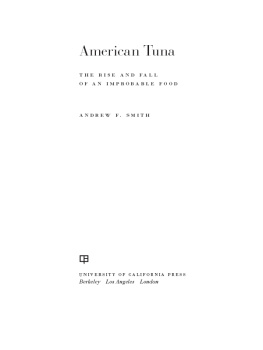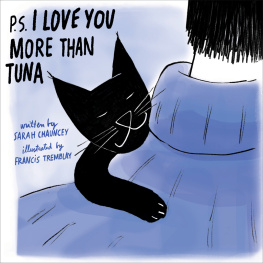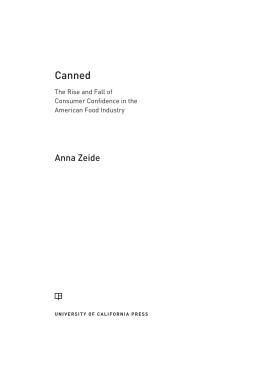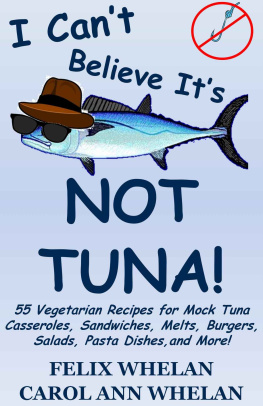
American Tuna
CALIFORNIA STUDIES IN FOOD AND CULTURE
Darra Goldstein, Editor
1. Dangerous Tastes: The Story of Spices, by Andrew Dalby
2. Eating Right in the Renaissance, by Ken Albala
3. Food Politics: How the Food Industry Influences Nutrition and Health, by Marion Nestle
4. Camembert: A National Myth, by Pierre Boisard
5. Safe Food: The Politics of Food Safety, by Marion Nestle
6. Eating Apes, by Dale Peterson
7. Revolution at the Table: The Transformation of the American Diet, by Harvey Levenstein
8. Paradox of Plenty: A Social History of Eating in Modern America, by Harvey Levenstein
9. Encarnacins Kitchen: Mexican Recipes from Nineteenth-Century California: Selections from Encarnacin Pinedos El cocinero espaol, by Encarnacin Pinedo, edited and translated by Dan Strehl, with an essay by Victor Valle
10. Zinfandel: A History of a Grape and Its Wine, by Charles L. Sullivan, with a foreword by Paul Draper
11. Tsukiji: The Fish Market at the Center of the World, by Theodore C. Bestor
12. Born Again Bodies: Flesh and Spirit in American Christianity, by R. Marie Griffith
13. Our Overweight Children: What Parents, Schools, and Communities Can Do to Control the Fatness Epidemic, by Sharron Dalton
14. The Art of Cooking: The First Modern Cookery Book, by The Eminent Maestro Martino of Como, edited and with an introduction by Luigi Ballerini, translated and annotated by Jeremy Parzen, and with fifty modernized recipes by Stefania Barzini
15. The Queen of Fats: Why Omega-3s Were Removed from the Western Diet and What We Can Do to Replace Them, by Susan Allport
16. Meals to Come: A History of the Future of Food, by Warren Belasco
17. The Spice Route: A History, by John Keay
18. Medieval Cuisine of the Islamic World: A Concise History with 174 Recipes, by Lilia Zaouali, translated by M. B. DeBevoise, with a foreword by Charles Perry
19. Arranging the Meal: A History of Table Service in France, by Jean-Louis Flandrin, translated by Julie E. Johnson, with Sylvie and Antonio Roder; with a foreword to the English language edition by Beatrice Fink
20. The Taste of Place: A Cultural Journey into Terroir, by Amy B. Trubek
21. Food: The History of Taste, edited by Paul Freedman
22. M. F. K. Fisher among the Pots and Pans: Celebrating Her Kitchens, by Joan Reardon, with a foreword by Amanda Hesser
23. Cooking: The Quintessential Art, by Herv This and Pierre Gagnaire, translated by M. B. DeBevoise
24. Perfection Salad: Women and Cooking at the Turn of the Century, by Laura Shapiro
25. Of Sugar and Snow: A History of Ice Cream Making, by Jeri Quinzio
26. Encyclopedia of Pasta, by Oretta Zanini De Vita, translated by Maureen B. Fant, with a foreword by Carol Field
27. Tastes and Temptations: Food and Art in Renaissance Italy, by John Varriano
28. Free for All: Fixing School Food in America, by Janet Poppendieck
29. Breaking Bread: Recipes and Stories from Immigrant Kitchens, by Lynne Christy Anderson, with a foreword by Corby Kummer
30. Culinary Ephemera: An Illustrated History, by William Woys Weaver
31. Eating Mud Crabs in Kandahar: Stories of Food during Wartime by the Worlds Leading Correspondents, edited by Matt McAllester
32. Weighing In: Obesity, Food Justice, and the Limits of Capitalism, by Julie Guthman
33. Why Calories Count: From Science to Politics, by Marion Nestle and Malden Nesheim
34. Curried Cultures: Globalization, Food, and South Asia, edited by Krishnendu Ray and Tulasi Srinivas
35. The Cookbook Library: Four Centuries of the Cooks, Writers, and Recipes That Made the Modern Cookbook, by Anne Willan, with Mark Cherniavsky and Kyri Claflin
36. Coffee Life in Japan, by Merry White
37. American Tuna: The Rise and Fall of an Improbable Food, by Andrew F. Smith
38 A Feast of Weeds: Foraging and Cooking with Edible Plants, by Luigi Ballerini, translated by Gianpiero W. Doebler
39. The Philosophy of Food, by David M. Kaplan

University of California Press, one of the most distinguished university presses in the United States, enriches lives around the world by advancing scholarship in the humanities, social sciences, and natural sciences. Its activities are supported by the UC Press Foundation and by philanthropic contributions from individuals and institutions. For more information, visit www.ucpress.edu.
University of California Press
Berkeley and Los Angeles, California
University of California Press, Ltd.
London, England
2012 by The Regents of the University of California
Library of Congress Cataloging-in-Publication Data
Smith, Andrew F.
American tuna : the rise and fall of an improbable food / Andrew F. Smith.
p. cm. (California studies in food and culture ; 37)
Includes bibliographical references and index.
ISBN 978-0-520-26184-6 (cloth, alk. paper)
1. TunaUnited StatesHistory. 2. Canned tunaUnited StatesHistory. 3. Fish as foodUnited StatesHistory. 4. Tuna fisheriesHistory. 5. Tuna fisheriesEnvironmental aspectsHistory. 6. Tuna industryHistory. 7. Cooking (Tuna) I. Title.
TX385.S65 2012
641.3'92dc23
2012000822
Manufactured in the United States of America
21 20 19 18 17 16 15 14 13 12
10 9 8 7 6 5 4 3 2 1
In keeping with its commitment to support environmentally responsible and sustainable printing practices, UC Press has printed this book on Cascades Enviro 100, a 100% post consumer waste, recycled, de-inked fiber. FSC recycled certified and processed chlorine free. It is acid free, Ecologo certified, and manufactured by BioGas energy.
Contents
Preface
Tuna histories usually begin in the Mediterranean, and for good reason. Tuna spawn in the eastern Mediterranean, and each year they migrate through the Mediterranean to the Straits of Gibraltar and then head out into the Atlantic Ocean. Since the migration is an annual event, fishermen can predict within a few weeks when the fish will be passing near their shores. As soon as migrating tuna are spotted, fishermen flock to their boats and net as many fish as possible before the school moves on. Once in the open ocean, tuna have widely divergent migratory patterns, making their capture much more problematic.
For several thousand years fishermen in the Mediterranean have caught and consumed tuna. It comes as no surprise that ancient Greek and Roman texts make numerous references to tuna, and images of the fish appear in art and on coinage. References, artifacts, and archaeological digs have documented tunas history for thousands of years, and the fishs continued popularity in southern Europe and northern Africa is yet other reason to begin tunas history in the Mediterranean.
American tuna history, however, is not about the Mediterranean; it is mainly about the Pacific, where humans have caught and consumed tuna for more than 40,000 years, according to the latest archaeological evidence. Virtually all of the tuna that Americans have consumed for the past centuryand still eatcomes from the Pacific. Unlike the relatively well-documented Mediterranean tuna history, however, American tuna history is scanty until the twentieth century, and the record that survives is filled with paradoxes. These incongruities and the questions generated by them are where I began my research:
Next page









![Henry Fox - Seafood Salads 365: Enjoy 365 Days With Amazing Seafood Salad Recipes In Your Own Seafood Salad Cookbook! [Tuna Recipes, Crab Cookbook, Healthy Seafood Cookbook, Mexican Seafood Cookbook] [Book 1]](/uploads/posts/book/288303/thumbs/henry-fox-seafood-salads-365-enjoy-365-days-with.jpg)






